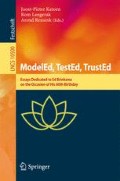Abstract
Hybrid and cyber-physical systems are at the intersection of the theory of concurrent processes and of systems and control theory. This paper reviews some ideas from systems and control theory, which can be considered to be fruitful for the study of such systems. Particular emphasis is on the use of dissipative systems theory for the analysis of interconnected systems, and on the ‘control by interconnection’ problem using an extension of the notion of (bi-)simulation to the realm of continuous dynamics. Furthermore, the paper surveys a definition of hybrid systems, which treats the continuous and discrete dynamics on an equal footing.
Access this chapter
Tax calculation will be finalised at checkout
Purchases are for personal use only
Notes
- 1.
Note that in the sequel we will also use the notations l, x, a, w for time-functions, mapping for each time instant t to elements \(l(t) \in \mathcal {L}, x(t) \in \mathcal {X}, a(t) \in \mathcal {A}, w(t) \in \mathcal {W}\), respectively.
References
Alur, R., Courcoubetis, C., Henzinger, T.A., Ho, P.-H.: Hybrid automata: an algorithmic approach to the specification and verification of hybrid systems. In: Grossman, R.L., Nerode, A., Ravn, A.P., Rischel, H. (eds.) HS 1991–1992. LNCS, vol. 736, pp. 209–229. Springer, Heidelberg (1993). doi:10.1007/3-540-57318-6_30
Bollobas, B.: Modern Graph Theory, Graduate Texts in Mathematics, vol. 184. Springer, Heidelberg (1998). doi:10.1007/978-1-4612-0619-4
Colgate, J.E., Hogan, N.: Robust control of dynamically interacting systems. Int. J. Control 48(1), 65–88 (1988)
Dashkovskiy, S., Ito, H., Wirth, F.: On a small-gain theorem for ISS networks in dissipative Lyapunov form. Eur. J. Control 17(4), 357–365 (2011)
Goebel, R., Sanfelice, R.G., Teel, A.R.: Hybrid Dynamical Systems: Modeling, Stability, and Robustness. Princeton University Press, Princeton (2012)
Hatanaka, T., Chopra, N., Fujita, M., Spong, M.W.: Passivity-Based Control and Estimation in Networked Robotics. Springer, Heidelberg (2011)
Khong, S.Z., van der Schaft, A.J.: Converse passivity theorems. In: Proceedings of the IFAC World Congress, pp. 9983–9986, Toulouse (2017)
Khong, S.Z., van der Schaft, A.J.: The converse of the passivity and small-gain theorem for nonlinear input-output maps. Submitted for publication (2017). arXiv:1707.00148
Megawati, N.Y., van der Schaft, A.J.: Bisimulation equivalence of differential-algebraic systems. Int. J. Control (2016). doi:10.1080/00207179.2016.1266519
Pappas, G.J.: Bisimilar linear systems. Automatica 39, 2035–2047 (2003)
Pola, G., van der Schaft, A.J., Di Benedetto, M.D.: Equivalence of switching linear systems by bisimulation. Int. J. Control 79, 74–92 (2006)
van der Schaft, A.: Bisimulation of dynamical systems. In: Alur, R., Pappas, G.J. (eds.) HSCC 2004. LNCS, vol. 2993, pp. 555–569. Springer, Heidelberg (2004). doi:10.1007/978-3-540-24743-2_37
van der Schaft, A.J.: Equivalence of dynamical systems by bisimulation. IEEE Trans. Autom. Control 49, 2160–2172 (2004)
van der Schaft, A.J.: Achievable behavior of general systems. Syst. Control Lett. 49, 141–149 (2003)
van der Schaft, A.J.: Equivalence of hybrid dynamical systems. In: Proceedings of the 16th International Symposium on Mathematical Theory of Networks and Systems (MTNS 2004), Leuven, Belgium, July 2004
van der Schaft, A.: \({L}_2\)-Gain and Passivity Techniques in Nonlinear Control. Springer, Cham (2017). doi:10.1007/978-3-319-49992-5. 3rd Revised and Enlarged edn. (1st edn. (1996), 2nd edn. (2000)), p. xviii + 321
van der Schaft, A.J., Jeltsema, D.: Port-Hamiltonian systems theory: an introductory overview. Found. Trends Syst. Control 1(2–3), 173–378 (2014). Now Publishers, Boston-Delft
van der Schaft, A.J., Schumacher, J.M.: An Introduction to Hybrid Dynamical Systems. LNCIS, vol. 251. Springer, London (2000). doi:10.1007/BFb0109998
Stramigioli, S.: Energy-aware robotics. In: Camlibel, M.K., Julius, A.A., Pasumarthy, R., Scherpen, J.M.A. (eds.) Mathematical Control Theory I. LNCIS, vol. 461, pp. 37–50. Springer, Cham (2015). doi:10.1007/978-3-319-20988-3_3
Vinjamoor, H., van der Schaft, A.J.: The achievable dynamics via control by interconnection. IEEE Trans. Autom. Control 56(5), 1110–1117 (2011)
Willems, J.C.: Dissipative dynamical systems, part I: general theory. Arch. Ration. Mech. Anal. 45(5), 321–351 (1972)
Willems, J.C.: On interconnections, control, and feedback. IEEE Trans. Autom. Control 42, 326–339 (1997)
Willems, J.C., Trentelman, H.L.: Synthesis of dissipative systems using quadratic differential forms, part I. IEEE Trans. Autom. Control 47, 53–69 (2002)
Zhou, K., Doyle, J.C., Glover, K.: Robust and Optimal Control. Prentice-Hall, Englewood Cliffs (1996)
Acknowledgements
After my collaboration with Hans Schumacher at the CWI on the topic of hybrid systems, I was very fortunate to be close to the Formal Methods and Tools group at the Computer Science department of the University of Twente, headed by Ed Brinksma. I happily remember the enjoyable and very stimulating conversations with especially Ed Brinksma, Rom Langerak and Joost-Pieter Katoen, also involving Jan Willem Polderman from the mathematics side. Among others this led to the celebrated NWO-CASH project. I still regard this collaboration as an exemplary case of open and fruitful collaboration. It is a great pleasure to dedicate this paper, which is heavily inspired by this collaboration, to Ed at the occasion of his 60th birthday. Happy birthday Ed!
Author information
Authors and Affiliations
Corresponding author
Editor information
Editors and Affiliations
Rights and permissions
Copyright information
© 2017 Springer International Publishing AG
About this chapter
Cite this chapter
van der Schaft, A. (2017). Analysis and Design of Interconnected Systems: A Systems and Control Perspective. In: Katoen, JP., Langerak, R., Rensink, A. (eds) ModelEd, TestEd, TrustEd. Lecture Notes in Computer Science(), vol 10500. Springer, Cham. https://doi.org/10.1007/978-3-319-68270-9_16
Download citation
DOI: https://doi.org/10.1007/978-3-319-68270-9_16
Published:
Publisher Name: Springer, Cham
Print ISBN: 978-3-319-68269-3
Online ISBN: 978-3-319-68270-9
eBook Packages: Computer ScienceComputer Science (R0)

